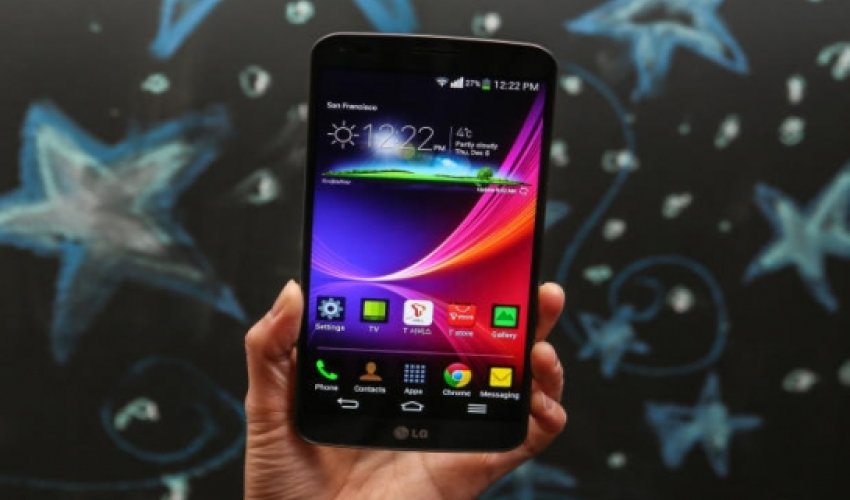LG G Flex Review - VIDEO

DesignDid I mention that this handset has a curved glass display? Oh, yes I did, and it´s just as well as it is the dominant design feature on the LG G Flex. There is no getting around the fact that this device is all about that curved silhouette, so I should waste no time in chatting about it. Looking straight at the device, the curve may be unnoticeable to some as it is very subtle, but from the side there is no hiding that semi-crescent form factor. When I placed the G Flex on a hard surface that curve was even more evident as the phone arched toward the ceiling. Other than that gentle bend, the G Flex is very much the same design as the flagship G2, which means I get almost no landscape bezels, a sleek if unspectacular design, and the love them or hate them rear button configurations. However, the Flex is a six-inch device as opposed to the 5.2-inch G2, so that all-screen look is amplified and is suitably impressive in hand, although I am not a fan of the glossy rear that looks a little tacky with its faux brushed metal. I would say that the design is above average without ever troubling the true “lookers” of the smartphone world, but I must give credit to the true innovation that the curved look brings.FeaturesI have just said that I don´t particularly like the glossy rear of the G Flex, but it is worth mentioning that it is like that for a reason. The handset is the first to come with a self healing finish, the kind that is normally found on marquee cars. The coating is designed to be more elastic, allowing it to revert to form if it is scratched or dented, and whichever way you cut it that is pretty cool and another innovation on LG´s part. Although, the coating can only withstand around 500g of pressure, so you may want to avoid taking your machete to it or launching it at a wall.HardwareThe G Flex sports the same stunning Qualcomm MSM8974 Snapdragon 800 Quad-core 2.26 GHz Krait 400 and an Adreno 330 GPU chipset as found in the G2, and there will be plenty more similarities between the two during this review. That processor has been paired with a hefty dose of RAM (2GB to be exact), while there is a Li-Po 3500 mAh battery and 32GB of internal storage of the non-expandable variety.Display and SoundLet´s be honest, this is the reason you´re all here. The curved screen tech on the G Flex has been much discussed in tech circles as many try to predict whether this technology will take off. Alongside the Samsung Galaxy Round, the G Flex is the only curved glass device available but that won´t be the case for long as the market is set to be worth $2.8 billion by 2018. LG then got on the bandwagon early with its curved device and the company knows that innovation costs (hence the price tag). So ignoring accusations of the screen being a gimmick, how does the panel on the G Flex stack up and is it worth dropping a lot more coin for?The answer right now is no… it´s not worth it. Is it a bad screen? Not at all, but it is also not a display that makes your jaw drop, which is a shame. With a name that has Flex in it I was expecting the G Flex to be… well, flexible and I was not disappointed as I could press down on the overturned device and make it go flush with the surface it was on. In other words, I could flatten it, which is daunting at first when you listen for fatal cracks and snaps, but LG insists the device is designed to withstand this kind of abuse. Not too much though as the Korean company does not give a weight limit, but a human pushing down with his or her hands should be fine. So the screen is flexible and durable, but that is not really the thing to judge a display on, so I fired the G Flex up to find out just how good (or bad) this panel is. Sadly I was disappointed as the six-inch Plastic OLED (POLED) RGB screen is only 720p, which as you may know is just about mid-range at the moment. Yes, that´s right, the innovative G-Flex has a worse screen than the flagship G2 and a myriad of other smartphones, while it costs hundred of dollars more. Putting my frustration aside, I could argue that this new technology is not at the level of being able to mass produce at 1080p, so I could give the benefit of the doubt. Of course, that lower resolution is instantly noticeable if you are used to running anything with a better panel, although the curved design scores points for giving unprecedented viewing angles. Performance and GraphicsThe G Flex wins points back with its performance as this is another powerhouse from LG. Featuring virtually the same specs as the G2, the handset is seriously fast, thanks to its all-conquering Qualcomm 2.26GHz quad-core Snapdragon 800 processor. As I said in the G2 review, this chip is a monstrous beast that chews up smartphone tasks with ease and makes the handset one of the quickest on the market. The G Flex is no different and until HTC and Samsung emerge with their 2014 flagships there is nothing quicker on Android. I completed multitasking and dual screen processes without issue and I am still in love with just how fast LG´s phones are at the moment. This of course translates perfectly to gaming, where the G Flex is among the best for graphic reproduction, although that 720p display hampers the overall gaming experience. The biggest issue here is that you can have the same performance and better screen on the G2, which costs hundreds of dollars less.Call QualityThere was nothing to complain about with call quality, and needless to say much will depend on your particular carrier and location. That said, I would put the G Flex on par with all flagships, while I was impressed with the speaker phone, perhaps because the curved screen angles the sound off surfaces as opposed to resonating on them.Data SpeedsAgain this depends on carrier, but the LG G Flex is well equipped to handle that fastest data speeds, and although I could not test LTE I did get between 6 Mbps and 10 Mbps on HSPA+.CameraI was unimpressed with the camera on the G2 and if anything the experience is worse on the G Flex, despite having many of the same features. That means there is a BSI 13-megapixel sensor, f/2.4 aperture lens, nine-point autofocus, and LED flash rear camera with 3.97mm focal length. Features from the G2 such as HDR, VR Panorama, Dual Camera, Shot & Clear (Eraser), burst shot, and intelligent auto have also made the journey to the G Flex, as has the ability to change ISO. However, unlike the G2 the G Flex misses out on optical image stabilization (OIS) because the module is too tall to fit into the device. The lack of this feature makes an already muddy experience worse and, while the camera remains feature-rich, it is nowhere near being the best on the market.Battery LifeThe 3000mAh battery on the LG G2 was among the best I have ever tested on a flagship and LG has raised the bar again with the 3500mAh pack inside the G Flex. I got 19.5 hours of solid use out of the handset and still had 31% left on the battery, which left me slack jawed, it has to be said.SoftwareFor some reason LG has refrained from staying on top of the Android platform and is pushing out handsets still running Android Jelly Bean 4.2.2 (two versions old). The company has not even committed to upgrading to Android 4.4 KitKat anytime soon, so if you’re buying any LG phone you won´t be up to date in terms of OS. That of course is a huge shame and it is made even worse by LG´s own infuriating Android tweaks that range from boring to plain pointless. I like the look of the interface on the G Flex but the UI is a bit muddled and annoying to use and I hope LG is paying attention to what is becoming a widespread issue among reviewers and customers.Configuration OptionsThe G Flex is available in a 32GB model for $940 unlocked.Warranty and SupportLike the G2, the G Flex comes with a one-year limited warranty while the company offers a repair service, an extended warranty plan, and parts and accessories. The company also offers a live chat service, email service, and phone service as well as having built-in apps on the device for support.Recommended CarrierThe G Flex is available in Asia and Europe on multiple carriers, but so far in the US it is only available through Sprint. The carrier is offering the handset at $299.99 on a two year contract or at a cheaper than expected $649.99 unlocked.SummaryA fantastic phone, yes, at least in terms of performance and battery life and I do like the G Flex. The problem is the innovative design is not mature enough as a technology to be taken too seriously and the screen is simply not up to scratch in relation to the price. I admire what LG has done, but won´t be rushing out to buy the G Flex.(tgreview.com)ANN.Az




































 Photo
Photo 



 Video
Video 

